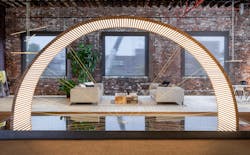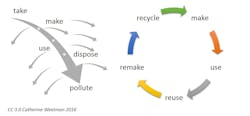LEDucation speakers provide links between decarbonization and circular economy
VIRTUAL EVENT RECAP, PART 1 — “Decarbonization” is a term on many people’s minds, especially given the widespread release of climate change research via mainstream media and ramped-up efforts for both public and private participation in sustainability efforts. Companies across all sectors and industries now release their own global impact statements and environmental goals with timelines for achievement. But how comfortable is the lighting design and supply chain with incorporating concepts such as operational carbon, embodied carbon, linear economy, and circular economy in its services and manufacturing practices?
During LEDucation’s virtual Monday session, two separate but equally revealing discussions addressed circular economy approaches emerging in Europe and North America. The first provided design and product manufacturing perspectives from industry stakeholders. The second, summarizing how Design for Disassembly (DfD) processes can reduce end-of-product-life waste, will be the subject of an additional event report.
Defining environmental and economic terms
Lighting designer and GreenLight Alliance contributing member Leela Shanker (Borealis Lighting Studio; New York, NY) led a roundtable in which panelists from the manufacturing, design and specification, and industry/market association segments talked through initiatives in achieving a lower carbon footprint and reduced waste — on both the policy level and the firm level — through product and design innovation.
Shanker first outlined basic principles and definitions for audience members to get the most out of the discussion. (This editor won’t assume that every reader is familiar with each term, as I was not.) A “linear economy” utilizes raw materials into finished products that typically end in waste at end of life (sometimes referred to as a “take–make–dispose” model). A “circular economy,” on the other hand, encourages more careful selection of materials from the beginning of product design in order to use only what is needed, then repurposing or recycling as much material as possible at the end of the product’s useful life cycle (“reduce–reuse–recycle”).
In terms of carbon impacts, Shanker explained, the more familiar “operational carbon” consists of the carbon and greenhouse gas emissions produced due to the consumption of energy in operation of a building or system. “Embodied carbon” results from emissions associated with the materials and construction processes throughout the life cycle of a building or of infrastructure (for example, in a municipal scenario).
Bring data to sustainable design
Shanker asked various panelists to describe measures taken by their respective organizations or guidelines prescribed to reduce environmental impacts on projects — and how they make a good business case for design and production choices.
Emilio Hernandez, chair of the GreenLight Alliance, explained that the role of the GreenLight Alliance was to advance circular economy concepts into the lighting industry. He cited the European Union’s Circular Economy Action Plan and the European Commission Eco-Design Directive, which have both been interpreted into recommended industry guidance on employing circular economy principles by LightingEurope. Hernandez said energy efficiency requirements, product labeling requirements, and reduced carbon objectives are driving circular design interest and efforts through global policy and regulations, product certifications encouraged through reporting frameworks, and new markets for remanufacturing as well as lighting as a service (LaaS) financing models.
Architectural lighting designer Iris Dijkstra (Atelier LEK; Rotterdam, the Netherlands) commented that she is working on many projects in the Netherlands, and “[the municipal authorities] are looking at what their citizens want and the sustainability of their communities,” easing the way for sustainable materials, designs, and low-impact implementation to be a part of the lighting design brief from the start.
Zumtobel Benelux region sales manager and sustainability ambassador Jonathan Visser shared a manufacturer’s perspective on bringing awareness to the EPD® (Environmental Product Declaration) – documentation that summarizes a product’s Life Cycle Assessment (LCA), “which is a study of all environmental impacts of a product across its life,” according to the Green Building Alliance. LCAs and EPDs are frequently utilized in the architecture, engineering, and construction (AEC) sectors.
In an effort to make the product specification process as transparent as possible, Visser said, “We started about 12 to 15 years ago developing EPDs. People became aware there wasn’t really a regulatory framework about how you produce your product, where is it coming from,” among other concerns. Although the EPD has not become a legal requirement in lighting discussions, “our clients the last decade or more have been requesting this of us,” Visser noted.
Much of the discussion centered on standardizing the use of LCA and EPD in lighting design and revealed that improving centralization of such information would go a long way toward adoption of those tools. This documentation would provide an environmental pedigree of sorts for every lighting material and design recommendation, paving the way for development and design decisions based on circularity.
Yuliya Savelyeva, formerly of engineering and design consultancy Arup (headquartered in London, UK), noted that data analyses are making their way into more client bids and meetings. However, she explained, gathering information to develop a sustainability analysis for all aspects of a project is very time consuming, especially if the LCA information is not readily available. “We need to find a way to [perform sustainability analyses] quickly, efficiently” in order to encourage more manufacturers to provide that data and more specifiers and designers to utilize the information in lighting plans, Savelyeva stated.
Russell Greenberg, RUX Design founder and co-founder of salvaged-wood fixture line Stickbulb (New York, NY), represented a smaller manufacturer of a more specialized niche in reused materials. He encouraged both designers and product developers to broaden their perspective on materials sourcing, localize it whenever possible, and consider whether a customer could be willing to pay more for products and materials with sustainable qualities to enable them to be repurposed or replaced with less waste. “There’s the sense that everything you need is right around the corner,” Greenberg said in explaining the approach to sourcing materials for modular Stickbulb luminaires. He showed an intriguing wooden LED light sculpture called “Ambassador,” designed for exhibition in 2017. The material started life as a massive redwood tree, which became a New York–based water tower structure, and then found reclaimed purpose in custom LED fixtures and pieces like Ambassador (shown in photo above).
Look for Part 2 of this event recap, outlining the DfD concepts in a second virtual session on putting circular principles to work in the lighting industry.
More resources
Visit the GreenLight Alliance to learn more about circular economy concepts
Download European Commission Circular Economy Action Plan
Visit LEDucation website for event updates
CARRIE MEADOWS is managing editor of LEDs Magazine, with 20 years’ experience in business-to-business publishing across technology markets including solid-state technology manufacturing, fiberoptic communications, machine vision, lasers and photonics, and LEDs and lighting.
For up-to-the-minute LED and SSL updates, why not follow us on Twitter? You’ll find curated content and commentary, as well as information on industry events, webcasts, and surveys on our LinkedIn Company Page and Facebook page.

Carrie Meadows | Editor-in-Chief, LEDs Magazine
Carrie Meadows has more than 20 years of experience in the publishing and media industry. She worked with the PennWell Technology Group for more than 17 years, having been part of the editorial staff at Solid State Technology, Microlithography World, Lightwave, Portable Design, CleanRooms, Laser Focus World, and Vision Systems Design before the group was acquired by current parent company Endeavor Business Media.
Meadows has received finalist recognition for LEDs Magazine in the FOLIO Eddie Awards, and has volunteered as a judge on several B2B editorial awards committees. She received a BA in English literature from Saint Anselm College, and earned thesis honors in the college's Geisel Library. Without the patience to sit down and write a book of her own, she has gladly undertaken the role of editor for the writings of friends and family.
Meadows enjoys living in the beautiful but sometimes unpredictable four seasons of the New England region, volunteering with an animal shelter, reading (of course), and walking with friends and extended "dog family" in her spare time.






